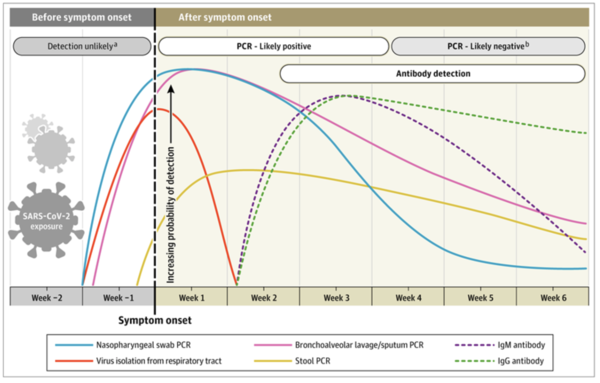(Excerpt)
The pandemic of coronavirus disease 2019 (COVID-19) continues to affect much of the world. Knowledge of diagnostic tests for severe acute respiratory syn- drome coronavirus 2 (SARS-CoV-2) is still evolving, and a clear understanding of the nature of the tests and interpretation of their findings is important. This Viewpoint describes how to interpret 2 types of diagnostic tests commonly in use for SARS-CoV-2 infections--reverse transcriptase-polymerase chain reaction (RT-PCR) and IgM and IgG enzyme-linked immunosorbent assay (ELISA)--and how the results may vary over time (Figure).
Detection of Viral RNA by RT-PCR
.....In most individuals with symptomatic COVID-19 infection, viral RNA in the nasopharyngeal swab as measured by the cycle threshold (Ct) becomes detectable as early as day 1 of symptoms and peaks within the first week of symptom onset. .....This positivity starts to decline by week 3 and subsequently becomes undetectable. However, the Ct values obtained in severely ill hospitalized patients are lower than the Ct values of mild cases, and PCR positivity may persist beyond 3 weeks after illness onset when most mild cases will yield a negative result.2 However, a "positive" PCR result reflects only the detection of viral RNA and does not necessarily indicate presence of viable virus.
.....In a study of 9 patients, attempts to isolate the virus in culture were not successful beyond day 8 of illness onset, which correlates with the decline of infectivity beyond the first week. That is in part why the "symptom-based strategy" of the Centers for Disease Control and Prevention (CDC) indicates that health care workers can return to work, if "at least 3 days (72 hours) have passed since recovery defined as resolution of fever without the use of fever-reducing medications and improvement in respiratory symptoms (e.g., cough, shortness of breath); and, at least 10 days have passed since symptoms first appeared."
.....The timeline of PCR positivity is different in specimens other than nasopharyngeal swab. PCR positivity declines more slowly in sputum and may still be positive after nasopharyngeal swabs are negative. In one study, PCR positivity in stool was observed in 55 of 96 (57%) infected patients and remained positive in stool beyond nasopharyngeal swab by a median of 4 to 11 days, but was unrelated to clinical severity.
Detection of Antibodies to SARS-CoV-2
COVID-19 infection can also be detected indirectly by measuring the host immune response to SARS-CoV-2 infection. Serological diagnosis is especially important for patients with mild to moderate illness who may present late, beyond the first 2 weeks of illness onset. Serological diagnosis also is becoming an important tool to understand the extent of COVID-19 in the community and to identify individuals who are immune and potentially "protected" from becoming infected.
The most sensitive and earliest serological marker is total antibodies, levels of which begin to increase from the second week of symptom onset. Although IgM and IgG ELISA have been found to be positive even as early as the fourth day after symptom onset, higher levels occur in the second and third week of illness.
SARS-CoV-2の診断検査の解釈について (JAMA. 2020.05.06)
(抜粋)
コロナウイルス感染症2019(COVID-19)のパンデミックは、世界の多くの地域に影響を与え続けている。重症急性呼吸器症候群コロナウイルス2(SARS-CoV-2)の診断検査に関する知識はまだ発展途上であり、検査の性質と所見の解釈を明確に理解することが重要である。本ビューポイントでは、SARS-CoV-2 感染症に一般的に使用されている 2 種類の診断検査である逆転写酵素ポリメラーゼ連鎖反応(RT-PCR)および IgM および IgG 酵素結合免疫吸着アッセイ(ELISA)の解釈方法と、その結果が経時的にどのように変化するかについて説明する(図)。
RT-PCR によるウイルス RNA の検出
........症候性COVID-19感染症のほとんどの人では、サイクル閾値(Ct)によって測定される鼻咽頭スワブ中のウイルスRNAは、症状が出現する1日目には早くも検出可能となり、症状の発症から1週間以内にピークを迎える。........この陽性率は3週目までに低下し始め、その後は検出不能となる。しかし、重症の入院患者で得られるCt値は軽症例のCt値よりも低く、PCR陽性は発症後3週間を超えても持続する可能性がある。
........9人の患者を対象とした研究では、培養でウイルスを分離しようとする試みは、発症から8日目以降は成功しなかった。これが、疾病対策予防センター(CDC)の「症状に基づく戦略」が、"熱を下げる薬を使用せずに熱が解決し、呼吸器症状(咳、息切れなど)が改善したと定義される回復から少なくとも 3 日間(72 時間)が経過しており、症状が最初に現れてから少なくとも 10 日間が経過している場合"は医療従事者が仕事に復帰できることを示している理由の一部である。
........鼻咽頭スワブ以外の検体では、PCR陽性のタイムラインが異なる。 ある研究では、便中の PCR 陽性は 96 人中 55 人(57%)の感染者で観察され、中央値で 4~11 日間、鼻咽頭スワブを超えても便中で陽性を維持していたが、臨床重症度とは無関係であった。
SARS-CoV-2 に対する抗体の検出
COVID-19感染は、SARS-CoV-2感染に対する宿主免疫応答を測定することによって間接的に検出することもできる。血清学的診断は、発症後 2 週間を超えて遅れて発症する可能性のある軽症から中等症の患者にとって特に重要である。また、血清学的診断は、地域社会におけるCOVID-19の程度を理解し、免疫があり、感染から「保護されている」可能性のある個人を特定するための重要なツールになりつつある。
最も感度が高く、最も早い血清学的マーカーは抗体であり、そのレベルは症状発症2週目から上昇し始めます。IgMおよびIgG ELISAは、症状発症後4日目にも陽性であることが確認されていますが、より高いレベルは発症2週目と3週目に現れる。

図について
Symptom onset: 症状発現
青線 鼻咽頭拭い液のPCR検査
ピンク 気管支洗浄液・痰のPCR検査
黄色 便のPCR検査
赤線 気道からのウイルス分離
点線 抗体検査
(Smart119スタッフコメント)
Sundararaj Stanleyraj Jeremiah先生らの論文。診断検査結果の時間的推移をわかりやすくグラフ化しています。興味がある方はぜひ原文をご確認ください。
https://jamanetwork.com/journals/jama/fullarticle/2765837